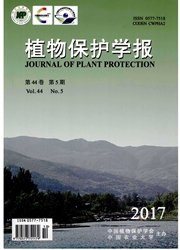

 中文摘要:
中文摘要:
为筛选防治牡丹红斑病的杀菌剂,采用涂布平板法测定了多菌灵、戊唑醇、嘧菌酯对病菌分生孢子形成和萌发的影响。结果表明:3种杀菌剂对病菌孢子萌发均有很强的抑制作用,浓度越高,抑制作用越强,以嘧菌酯最强,1μg/mL浓度处理其孢子萌发率低于10%,5μg/mL处理孢子完全不能萌发;3种杀菌剂均可显著抑制病菌芽管的伸长生长,1μg/mL处理下孢子萌发24 h后芽管长度均不足10μm,5μg/mL处理对芽管伸长的抑制率达到90%;3种杀菌剂可使分生孢子及芽管发生畸形,多菌灵的致畸作用最强,0.1μg/mL处理即表现出明显的致畸作用,而戊唑醇致畸作用较弱;嘧菌酯和戊唑醇对病菌产孢结构形成和分生孢子产生数量有强烈的抑制作用,0.05μg/mL浓度下即完全不产孢,但多菌灵在0.05μg/mL浓度下则促进病菌产孢结构形成及产孢量增加。表明3种杀菌剂均可作为保护剂在病害发生前期喷施,但在流行期应尽量使用嘧菌酯和戊唑醇,以减少病菌再侵染数量。
 英文摘要:
英文摘要:
In order to screen fungicides to control peony red spot caused by Cladosporium paeoniae,the inhibitory activity of carbendazim,tebuconazole and azoxystrobin against the sporulation and conidial germination of C. paeoniae were determined. The results showed that all the three fungicides could strongly decrease conidial germination rate and the increase in fungicide concentration caused the rise of the inhibitory effect. The inhibitory activity of azoxystrobin was the strongest,which could decrease the germination rate below 10% at the concentration of 1 μg / mL and cause no germination at 5 μg / mL.They strongly inhibited the germ tube growth of conidia. After germination for 24 hours,the length of germ tube was less than 10 cm. The inhibitory rate of germ tube growth at the concentration of 5 μg / mL reached 90%. All the three fungicides caused the abnormality of conidia and germ tubes. Carbendazim had the most obvious effects,which resulted in abnormality even at the concentration of 0. 1 μg / mL.However,the effects of tebuconazole were unconspicuous. Tebuconazole and azoxystrobin delayed sporulation and produced a strong inhibition of spore yields,whereas carbendazim promoted sporulation atthe concentration of 0. 05 μg / mL. All the three fungicides could be used as protective agents before the appearance of the peony red spot; when the disease became prevalent,azoxystrobin and tebuconazole should be used preferentially as a curative fungicide to avoid secondary infection.
 同期刊论文项目
同期刊论文项目
 同项目期刊论文
同项目期刊论文
 期刊信息
期刊信息
